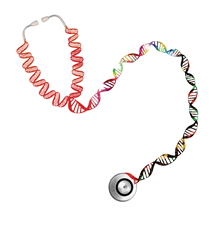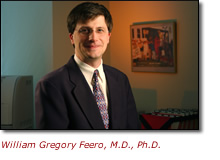Last updated: June 18, 2010
Building Bridges: Moving Genomics Into Clinical Care
Building Bridges: Moving Genomics Into Clinical Care
 The National Human Genome Research Institute (NHGRI) has recently created the Genomic Healthcare Branch (GHB) to help bridge the gap between genomic discoveries made in the research lab and the realities faced by patients and healthcare providers in the clinic.
The National Human Genome Research Institute (NHGRI) has recently created the Genomic Healthcare Branch (GHB) to help bridge the gap between genomic discoveries made in the research lab and the realities faced by patients and healthcare providers in the clinic.
"Genomic technologies have already made substantial inroads into everyday clinical practice. In the future, genomics will become even more central to clinical care. It is critical that healthcare providers are prepared to use these technologies to care for their patients," said W. Gregory Feero, M.D., Ph.D., chief of the Genomic Healthcare Branch, which is part of the Office of Policy, Communication and Education within NHGRI's Office of the Director.
 Dr. Feero and his colleagues possess first-hand knowledge of the many challenges facing today's healthcare professionals as they attempt to integrate genomic tools and technologies into their daily practice. Trained as a family practice physician and as a research geneticist, Dr. Feero still spends one day a week seeing patients in a clinic in West Virginia.
Dr. Feero and his colleagues possess first-hand knowledge of the many challenges facing today's healthcare professionals as they attempt to integrate genomic tools and technologies into their daily practice. Trained as a family practice physician and as a research geneticist, Dr. Feero still spends one day a week seeing patients in a clinic in West Virginia.
Other branch members have extensive experience in primary care, nursing and health education. Jean Jenkins, R.N., Ph.D., has more than 30 years of experience as a nurse and nurse educator. Dale Lea, R.N., M.P.H., C.G.C., is a genetics counselor and health educator. She has developed genetics, health education, and community involvement programs and resources. Alan Guttmacher, M.D., is a former director of the Vermont Regional Genetics Center at the University of Vermont College of Medicine where he practiced clinical genetics, conducted research, and was a tenured associate professor of pediatrics and medicine. In addition to his adjunct position with the Genomic Healthcare Branch, Dr. Guttmacher currently serves as the deputy director of NHGRI.
"Clearly, there are many priorities competing for the healthcare provider's time in the context of the all-too-short office visit. One of our priorities is to find novel ways to integrate genomics into healthcare that have a minimal — and possibly positive — impact on the time crunch everyone in medicine feels," said Dr. Feero.
The new branch will use a wide range of approaches to reach out to doctors, nurses, physician assistants and other healthcare professionals to help them leverage state-of-the-art genomic technologies. For example, the branch evaluates and develops educational materials, such as a toolkit for nursing faculty to teach genetic and genomic competencies and other Web-based learning tools on genetics and genomics for health providers. Branch staff also write and edit articles focusing on genomics for professional journals and other educational publications aimed at healthcare professionals.
 In addition, representatives of the Genomic Healthcare Branch will attend and convene meetings with the intent of enhancing healthcare professionals' knowledge of the latest research related to genomics and clinical care. For example, the branch currently is planning a State-of-the-Science Conference on the use of family health history as a screening tool in primary care. The conference, which will take place within the next two years, will be held at the National Institutes of Health (NIH) in Bethesda, Md. The branch is also coordinating a meeting to examine carrier screening in the context of emerging genomic technologies. This event, which will be hosted in conjunction with other partners from NIH, the Centers for Disease Control and Prevention, and the Health Resources and Services Administration, is expected to take place in the spring of 2008.
In addition, representatives of the Genomic Healthcare Branch will attend and convene meetings with the intent of enhancing healthcare professionals' knowledge of the latest research related to genomics and clinical care. For example, the branch currently is planning a State-of-the-Science Conference on the use of family health history as a screening tool in primary care. The conference, which will take place within the next two years, will be held at the National Institutes of Health (NIH) in Bethesda, Md. The branch is also coordinating a meeting to examine carrier screening in the context of emerging genomic technologies. This event, which will be hosted in conjunction with other partners from NIH, the Centers for Disease Control and Prevention, and the Health Resources and Services Administration, is expected to take place in the spring of 2008.
The branch also is working to standardize informatics technologies developed by governmental institutions for collecting and storing family health history information. The goal is to establish a standard family history tool that can link information to electronic health records systems. To accomplish this goal, Dr. Feero and his colleagues participate in the American Health Information Community Personalized Healthcare Workgroup and play a lead role in networking with other federal agencies involved in health informatics applications.
"Incorporating family health history into electronic health records would make it possible for healthcare providers to quickly get an idea of whether a patient has genetic factors that might put him or her at increased risk for disease. Healthcare providers could then use this information to recommend follow-up tests, as well as strategies for disease management and prevention. What's more, electronic health records would enable this information to be quickly and easily shared with specialists or other healthcare professionals in a wide range of clinical settings," said Dr. Feero.
Another vital role of the new branch is to serve as a liaison between NHGRI and other public and private organizations with an interest in moving genomics into the clinical setting. Recently, branch staff participated in meetings with the American Academy of Family Physicians and with the physician assistant community. Also, Genomic Healthcare Branch partnerships with professional nursing organizations are expanding awareness of the importance of integrating genetic and genomic knowledge into healthcare. For example, collaboration with the American Nurses Association resulted in meetings to finalize an "Essentials Competency" document, which has been endorsed by 48 organizations (See: Essential Nursing Competencies and Curricula Guidelines for Genetics and Genomics ![]() ), as well as follow-up meetings to create a strategic plan for these efforts. Included in this strategic plan is a Toolkit for Faculty which is in the process of being developed with the support of the American Association of Colleges of Nursing. Additionally, the American Academy of Nursing is working with Dr. Jenkins to determine how to establish the evidence base in support of using genomic applications in nursing care.
), as well as follow-up meetings to create a strategic plan for these efforts. Included in this strategic plan is a Toolkit for Faculty which is in the process of being developed with the support of the American Association of Colleges of Nursing. Additionally, the American Academy of Nursing is working with Dr. Jenkins to determine how to establish the evidence base in support of using genomic applications in nursing care.
The Genomic Healthcare Branch also participates in various education research projects. One project, which is being conducted in collaboration with researchers from NHGRI's Social and Behavioral Research Branch, will analyze data from a large survey that asked family physicians about their attitudes and practices related to genomics.
"The NHGRI is proud of its leadership in such programs as the Human Genome Project, the ENCODE Project, the HapMap Project and the Genes and Environment in Health Initiative," said Dr. Guttmacher. "However, we realize that the ultimate worth of such efforts will be the use of the genomic tools and approaches that they have pioneered to improve human health. We look forward to our new Genome Healthcare Branch playing an important role — in partnership with other governmental agencies, health advocates, the private sector and health professionals — in translating these tools and approaches so that the promise of genomics becomes the reality of better health for all."
To view the PDF on this page you will need Adobe Acrobat Reader. ![]()